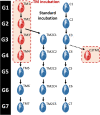Thermal conditioning of quail embryos has transgenerational and reversible long-term effects
- PMID: 37784159
- PMCID: PMC10546792
- DOI: 10.1186/s40104-023-00924-2
Thermal conditioning of quail embryos has transgenerational and reversible long-term effects
Abstract
Background: In the current context of global warming, thermal manipulation of avian embryos has received increasing attention as a strategy to promote heat tolerance in avian species by simply increasing the egg incubation temperature. However, because of their likely epigenetic origin, thermal manipulation effects may last more than one generation with consequences for the poultry industry. In this work, a multigenerational and transgenerational analysis of thermal manipulation during embryogenesis was performed to uncover the long-term effects of such procedure.
Results: Thermal manipulation repeated during 4 generations had an effect on hatchability, body weight, and weight of eggs laid in Japanese quails, with some effects increasing in importance over generations. Moreover, the effects on body weight and egg weight could be transmitted transgenerationally, suggesting non-genetic inheritance mechanisms. This hypothesis is reinforced by the observed reversion of the effect on growth after five unexposed generations. Interestingly, a beneficial effect of thermal manipulation on heat tolerance was observed a few days after hatching, but this effect was not transgenerational.
Conclusions: Our multigenerational study showed that thermal conditioning of quail embryos has a beneficial effect on post-hatch heat tolerance hampered by transgenerational but reversible defects on growth. Assuming that no genetic variability underlies these changes, this study provides the first demonstration of epigenetic inheritance of traits induced by environmental temperature modification associated with long-term impacts in an avian species.
Keywords: Avian; Embryo; Programming; Temperature; Transgenerational inheritance.
© 2023. Chinese Association of Animal Science and Veterinary Medicine.
Conflict of interest statement
The authors declare that they have no competing interests.
Figures




References
-
- Andrieux C, Petit A, Collin A, Houssier M, Métayer-Coustard S, Panserat S, et al. Early Phenotype Programming in Birds by Temperature and Nutrition: A Mini-Review. Front Anim Sci. 2022;2:755842. doi: 10.3389/fanim.2021.755842. - DOI
Grants and funding
LinkOut - more resources
Full Text Sources

